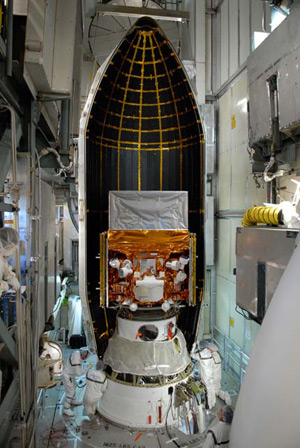Original URL: https://www.theregister.com/2008/06/10/glast_launch/
NASA preps GLAST for blast-off
Gamma-ray 'scope good to go
Posted in Science, 10th June 2008 09:17 GMT
NASA is making final preparations for tomorrow's lift-off of the Gamma-Ray Large Area Space Telescope (GLAST) atop a Delta II rocket from Cape Canaveral Air Force Station.
 Launch of the "powerful space observatory" (seen here inside one half of its payload fairing) is slated for between 15:45 and 17:40 GMT. It will "open a wide window on the universe", according to the agency, which summarises: "With a huge leap in all key capabilities, GLAST data will enable scientists to answer persistent questions across a broad range of topics, including supermassive black-hole systems, pulsars, the origin of cosmic rays, and searches for signals of new physics."
Launch of the "powerful space observatory" (seen here inside one half of its payload fairing) is slated for between 15:45 and 17:40 GMT. It will "open a wide window on the universe", according to the agency, which summarises: "With a huge leap in all key capabilities, GLAST data will enable scientists to answer persistent questions across a broad range of topics, including supermassive black-hole systems, pulsars, the origin of cosmic rays, and searches for signals of new physics."
Specifically, GLAST's mission priorities are: "To understand the mechanisms of particle acceleration in active galactic nuclei (AGNs), neutron stars, and supernova remnants (SNRs); to resolve the gamma-ray sky: characterize unidentified sources and diffuse emission; to determine the high-energy behavior of gamma-ray bursts (GRBs) and variable sources; and to probe dark matter and the early Universe."
GLAST differs from NASA's Swift, launched in 2004, in that while the latter "can rapidly and precisely determine the locations of GRBs and observe their afterglows at X-ray, ultraviolet, and optical wavelengths, the former will deliver "exquisite observations of the burst over the gamma-ray spectrum, giving scientists their first complete view of the total energy released in these extraordinary events".
Once launched, GLAST will reside in a low-Earth circular orbit at a nominal 565km altitude and an inclination of around 24.7 degrees. It'll circle the Earth every 90 minutes, allowing it to map the entire sky roughly every three hours.
To do this, GLAST carries three instruments: Anticoincidence Detector ("A system on a gamma-ray observatory that triggers when it detects an incoming charged particle (cosmic ray) so that the telescope will not mistake it for a gamma ray"); Calorimeter ("A detector that absorbs particles and photons, producing an electrical signal proportional to the total incident energy [which] can be used to measure a gamma ray’s energy"); and GLAST Burst Monitor (GBM) ("The instrument on GLAST that is specifically designed to detect gamma-ray bursts").
GLAST has a mission life of five years, with NASA hoping for 10 years' results from the 'scope. There's an overview of the mission here (pdf), FAQ here and the main GLAST site here. ®